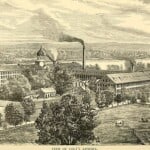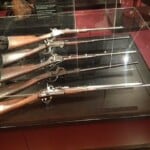
Introduction to Confederate Firearms
The American Civil War was a crucible that tested the mettle of the United States, a nation on the brink of dissolution over deep-seated issues such as state rights and slavery. The war's outcome depended heavily on the men who fought, their tactics, and the weaponry they wielded. Confederate firearms layed a role. While the Union possessed considerable advantage in terms of manufacturing, the Confederacy managed to establish its own robust system for producing weaponry, specifically firearms. This expanded examination will delve into the Southern firearms of the Civil War, focusing on the manufacturers, models, production numbers, and a comparative analysis with Union weaponry.
Government-Run Armories
Richmond Armory
At the helm of Confederate manufacturing was the Richmond Armory, located in the capital of Virginia. Highly influenced by the Union's Springfield Armory, it was the primary governmental manufacturing facility. From its inception, Richmond Armory produced an estimated 32,000 "Richmond Rifles". These weapons were direct analogues of the U.S. Model 1855 Rifled Musket, sharing its basic design and functionalities. Richmond was one of the several government-run armories turning out Confederate firearms.
The Richmond Rifle, with a .58 caliber, was a muzzle-loading rifled musket, operating via a percussion cap ignition system. It was a weapon lauded for its reliability and accuracy. Nevertheless, being a muzzle-loader, its rate of fire was somewhat limited, with a proficient soldier achieving only three to four rounds per minute. Distinctive attributes of the Richmond Rifle included its brass butt plate, nose cap, and barrel bands.
Fayetteville Arsenal
The Fayetteville Arsenal, located in North Carolina, was another significant Confederate stronghold for weapon production. The arsenal primarily specialized in manufacturing rifled muskets, becoming renowned for its "Fayetteville Rifle". The Fayetteville Rifle closely emulated the U.S. Model 1855 Rifled Musket, akin to the Richmond Rifle. Fayetteville was another major government-run producer of Confederate firearms.
From 1862 until the war's end in 1865, Fayetteville generated approximately 10,000 rifles. This figure epitomizes the Confederacy's challenges in terms of weapon production compared to the Union. Fayetteville Rifles were .58 caliber weapons, equipped with a percussion cap system mirroring the Richmond Rifle.
State Military Works at Greenville SC
Another significant firearm produced during the Civil War by the Confederacy was the Morse Carbine. Developed by George W. Morse, an inventive gunsmith from South Carolina, the Morse Carbine was renowned for its advanced features for the time. The carbine was a breech-loading firearm, distinguishing it from the more common muzzle-loaders.
This design allowed for a faster rate of fire and easier reloading, particularly advantageous while on horseback. One unique feature of the Morse Carbine was its early adoption of centerfire metallic cartridges, a technology that would become standard in the decades following the Civil War but was quite novel at the time. Approximately 1,000 Morse Carbines were produced at the State Military Works in Greenville, South Carolina, further demonstrating the innovation capacity of Confederate firearms manufacturers under challenging circumstances.
Private Firms
While the majority of Confederate firearms were produced by the government or outright taken from the union, there were a number of notable private firms producing Confederate firearms in the south. Their products were as storied and legendary as any and they're generally prized by modern day collectors.
Cook & Brother
While government-run armories constituted a substantial portion of Confederate firearms production, private firms also played a crucial role. Among these, Cook & Brother, a firm founded by English immigrants Ferdinand and Francis Cook, emerged as one of the most successful. The firm managed factories in New Orleans, Louisiana, and Athens, Georgia, becoming a significant contributor to the inventory Confederate firearms.
Between 1861 and 1865, Cook & Brother crafted approximately 7,000 "Cook Rifles" and 6,500 "Cook Cavalry Carbines". These firearms, based on the .577 caliber Enfield pattern, were highly reliable and earned considerable praise from Confederate soldiers. The rifles were esteemed for their precision, while the carbines, due to their shorter length and reduced weight, became a popular choice among the Confederate cavalry.
Dance & Brothers
Located in East Columbia and Anderson, Texas, Dance & Brothers was another significant private firm. Their most noteworthy contribution was a near-identical copy of the Colt 1851 Navy revolver, but chambered in .44 caliber instead of the .36 caliber of the original Colt. Approximately 325 of these revolvers were manufactured during the course of the war. They were coveted by Confederate soldiers, given their larger caliber and the reputation of the original Colt design.
Griswold & Gunnison
Another crucial Southern private firm producing Confederate firearms was Griswold & Gunnison, headquartered in Georgia. The firm emerged as one
of the most prominent revolver producers in the Confederacy. Their revolvers were meticulously crafted to mirror the .36 caliber Colt 1851 Navy Revolver. They were able to produce about 3,600 of these revolvers during the war. Despite the comparatively low production numbers, Griswold & Gunnison revolvers were valued highly by Confederate soldiers due to their reliability and shared handling characteristics with the well-respected Colt 1851 Navy.
LeMat Revolver
The LeMat Revolver, a unique firearm design by Jean Alexandre LeMat of New Orleans, distinguished itself through its sheer power and versatility. This weapon featured a nine-shot .42 caliber cylinder along with a secondary 20-gauge smoothbore barrel, capable of discharging buckshot. This innovative design made it an extremely versatile weapon. Approximately 2,900 LeMat revolvers were crafted during the war, and though the numbers may seem small, the weapon's distinctive features made it a significant contribution to Confederate firepower.
Spiller & Burr
Spiller & Burr, another private firm located in Georgia and South Carolina, was well-known for producing a Confederate copy of the .36 caliber Whitney Navy Revolver. Despite facing various difficulties, including challenges in sourcing brass, Spiller & Burr managed to produce an estimated 1,500 revolvers. Though the manufacturing process led to some variations, these revolvers remained well-regarded due to their robust design.
Leech & Rigdon and Rigdon, Ansley & Company
In the realm of revolver manufacturing, Leech & Rigdon and its successor company, Rigdon, Ansley & Company, held a prominent place. They are known for producing close copies of the Colt 1851 Navy Revolver. Leech & Rigdon manufactured about 1,500 revolvers, while Rigdon, Ansley & Company continued the production, contributing an additional 1,900 revolvers. These Confederate Firearms were noted for their fine craftsmanship and were highly sought after by Confederate troops.
Augusta Machine Works
In the early years of the war, the Augusta Machine Works in Georgia manufactured a small number of Confederate Firearms in the form of "Mississippi Rifles", a .54 caliber weapon initially designed for the U.S. Model 1841 Rifle. However, their most significant contribution to the Confederate war effort was the manufacturing of heavy artillery and naval ordnance.
Comparative Analysis with Union Firearms
In the grand scheme of the war, the South was significantly outpaced by the Union in terms of weapon production. The Union's Springfield Armory alone generated over 800,000 Model 1861 Rifled Muskets. Additionally, private firms such as Colt managed to produce tens of thousands of Colt 1860 Army revolvers.
Quality-wise, many Confederate firearms were on par with their Union counterparts. However, the Confederacy lagged behind in terms of quantity. A stark difference in production numbers was a major contributing factor to the Union's victory. Furthermore, the Union was quicker to adopt and implement more advanced firearm technology, like repeating rifles and metallic cartridges, granting them a significant technological edge as the war progressed.
Conclusion
The Confederacy faced substantial challenges in manufacturing Confederate firearms during the American Civil War, but their production efforts were by no means trivial. From the high-quality Cook Rifles and Cavalry Carbines to the distinctive LeMat Revolver, the South managed to arm its soldiers with a variety of firearms that held their ground against Union weaponry.
However, the significant disparity in production numbers between the Confederacy and the Union played a crucial role in the war's outcome. The Confederacy produced tens of thousands of firearms while the Union produced hundreds of thousands. This, coupled with the Union's swift adoption of advanced firearm technology, ultimately gave them the upper hand.
These firearms, painstakingly crafted by the Confederacy, represent a compelling chapter in the study of American history. They reflect the ingenuity and resilience of the South under desperate circumstances, and the pivotal role they played in the shaping of the United States' future. The firearms of the Confederacy bear the marks of a critical era, imbued with the echoes of a bitter struggle that ultimately determined the course of the nation.
Several good books on the topic include:




If you know of any forums or sites that should be referenced on this listing, please let us know here.








